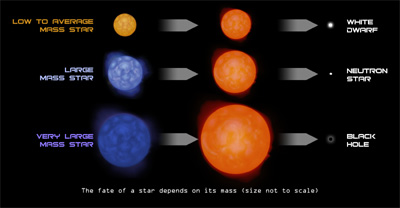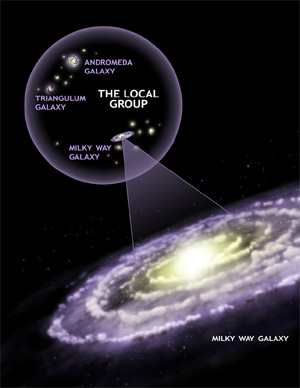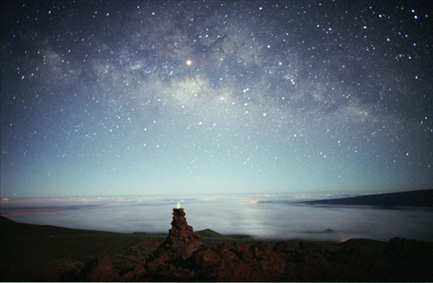
Credit & Copyright: Barney Magrath
The Milky Way's cosmic clouds of stars and dust stretch across this picture taken May 2001 from Hawaii. In the foreground is an "ahu hoku" - a star marker or star altar - built up of rocks topped with a white piece of coral glowing in the moonlight.
The word galaxy comes from a Greek word meaning "milky circle" or, more familiarly, "milky way." The white band of light across the night sky that we call the Milky Way was observed and described poetically long before Galileo examined it with a small telescope. What he discovered was a multitude of individual stars, "so numerous as almost to surpass belief."
Today we know that the Milky Way is our home galaxy - a vast rotating spiral of gas, dust, and hundreds of billions of stars. The Sun and its planetary system formed in the outer reaches of the Milky Way about 4.5 billion years ago.
In the center of the galaxy is the bar-shaped galactic bulge which harbors a supermassive black hole with a mass equal to that of about 3 million suns. Surrounding the central bulge is a relatively thin disk of stars about two thousand light years thick and roughly 100,000 light years across. Almost all the stars seen by the human eye are in the thin disk, which accounts for about 90% of the visible light in the Milky Way.

Giant clouds of dust and gas in the disk and bulge absorb light from the stars and give the galaxy its patchy appearance. These clouds are the stages on which the long-running drama of stellar evolution is played. Dust and gas collapse to form stars, then nuclear fusion reactions in their interiors build up heavier elements and release energy which is radiated as starlight.
As the stars' nuclear energy supply is exhausted, most stars will expand to become red giants, then shrink to a small dense state called a white dwarf star. Massive stars will explode as supernovas, leaving behind neutron stars or black holes. The explosions disperse heavy elements manufactured by the stars, thereby enriching the galaxy with elements necessary to form planets.
More on Stellar Evolution
The Galaxy's bright stellar disk is embedded in a faint, thicker disk of old stars. This disk, which has a thickness about 3 times that of the thin disk, may have been the original structure from which the thin disk condensed, or it could have been thickened by a collision with a smaller galaxy ten billion years ago.
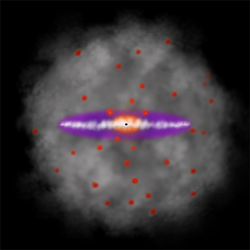
Schematic of Milky Way showing the dark matter halo (gray), globular clusters (red circles), the thick disk (purple), the stellar disk (white), the stellar bulge (red-orange), and the central black hole (black dot). The stellar disk is about 100,000 light years in diameter. The dark halo extends to a diameter of at least 600,000 light years. (Illustration: CXC/M.Weiss)
Surrounding the thick Galactic disk is an extremely faint halo that contains the oldest stars in the Galaxy. These stars are located in globular clusters, dense swarms of about 100,000 stars. The Galactic halo is dominated by dark matter, a still mysterious form of matter that cannot be seen with any type of telescope, but is detected by its gravitational effects. Studies of the motions of stars and gas in the Milky Way indicate that the mass of the dark matter halo is about twenty times greater than the mass of all the stars in the galaxy.
More on Dark Matter
It is thought that the various components of our Galaxy were put together about 12 billion years ago through a succession of mergers that are continuing even today. Clouds of gas are observed to be falling into our galaxy, and recent evidence indicates that a small galaxy on the far side of the Milky Way is being torn apart and assimilated into the Galaxy.
These processes emphasize that the Milky Way is not an island universe, but a member of a small cluster of galaxies called the Local Group. The Local Group contains about 3 dozen known galaxies, clumped in two subgroups around two massive spiral galaxies --the Milky Way, and the Andromeda Galaxy. In several billion years it is possible that the Milky Way and Andromeda will collide and merge to form one huge elliptical galaxy, so enjoy the Milky Way while you can!
TAKE A TRIP: Zoom out past Earth, Venus, Mercury & the Sun. Go beyond the solar system, and out of the Milky Way to our Local Group. (Credit: CXC/A.Hobart)
This artist's animation takes a virtual voyage from Earth through the Milky Way galaxy to the outer reaches of the Local Group of galaxies. Leaving Earth we pass the planets Venus and Mercury, then cruise by the Sun, the star of our solar system. We then travel about 24 trillion miles, or 4 light years, before we pass our neighboring stars in the Alpha Centauri complex.
At a distance of a few hundred light years we encounter clouds of dust and gas illuminated by brilliant clusters of young stars. These clouds and star clusters are part of the Orion spiral arm. As we move further out, fifty thousand light years from the Sun, other spiral arms of the Galaxy come into view along with the central bulge, where the Galaxy's supermassive black hole is located. Finally, from a distance of a few million light years, we see the Galaxy as part of the Local Group.
From the tranquil, wide-open spaces between the galaxies of the Local Group, we now zoom into where the action is - the brightly lit, crowded center of the Galaxy, the "Broadway" of our sprawling stellar metropolis. This 400 by 900 light-year mosaic of several Chandra images of the central region of our Milky Way galaxy reveals hundreds of white dwarf stars, neutron stars, and black holes bathed in an incandescent fog of multimillion-degree gas. The supermassive black hole at the center of the Galaxy is located inside the bright white patch in the center of the image. The colors indicate X-ray energy bands - red (low), green (medium), and blue (high).
RETURN TRIP: Zoom back in from the Local Group to the Galactic Center & view the Chandra mosaic of the central region of our Galaxy.
Animation: CXC/A.Hobart
Chandra X-ray Image: NASA/UMass/D.Wang et al.
The Chandra mosaic gives a new perspective on how the turbulent Galactic Center region affects the evolution of the Galaxy as a whole. Large quantities of multimillion degree gas appear to be escaping from the center into the rest of the Galaxy. The outflow of gas, chemically enriched from the frequent destruction of stars, will distribute these elements into the galactic suburbs.
A composite of images made at X-ray (blue), infrared (green), and radio (red) shows the relation between hot gas (X-ray), cool gas and dust (infrared) and high energy electrons trapped in the magnetic field in the Galactic center (radio). Because it is only about 26,000 light years from Earth, the center of our Galaxy provides an excellent laboratory to learn about the cores of other galaxies.
X-ray (blue), Infrared (green), Radio (red) or all three.
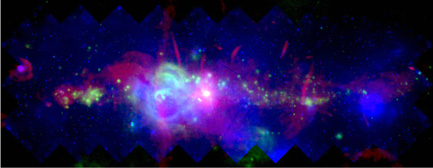
X-ray (blue), Infrared (green) and Radio (red) Composite.



